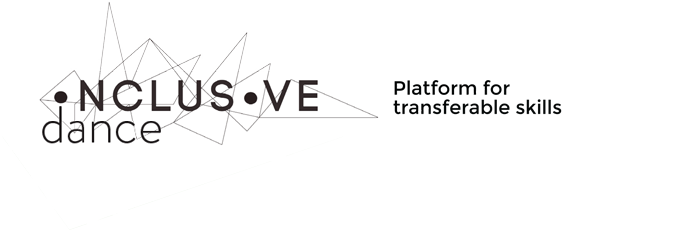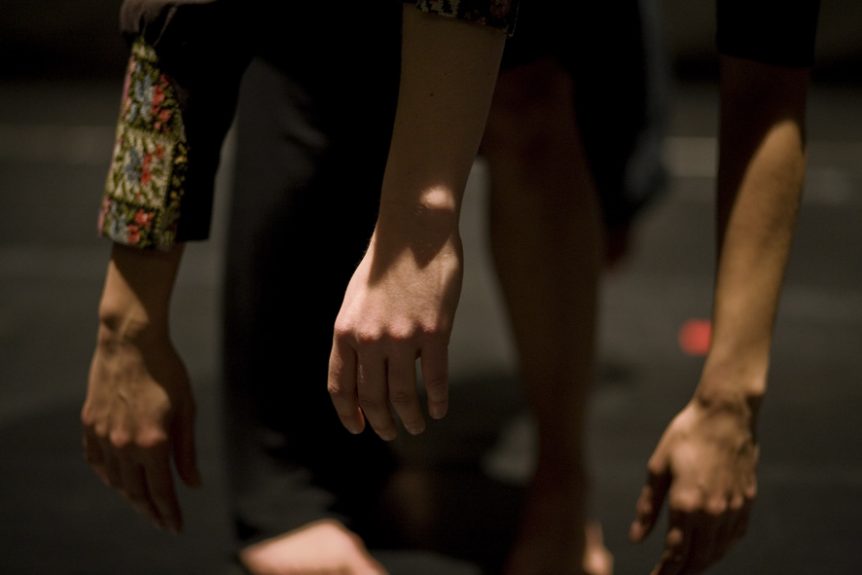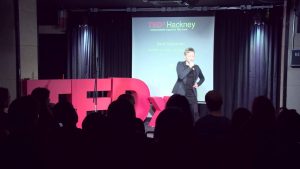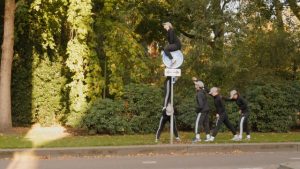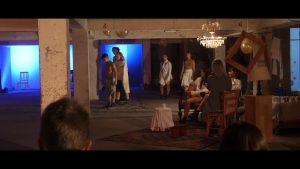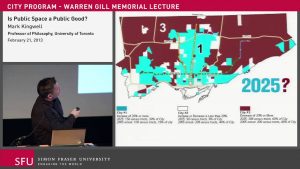In 2012, Iris Bouche and musicians/composers Kobe Proesmans and Gerrit Valkenaers worked on a new piece ‘Cutting Space’. In this dance project, the dancer/choreographer works with physical restrictions. Even in a ‘normal’ development of the human body, physical restrictions determine our physical abilities. Iris Bouche explores how those restrictions determine the shape, value and context of movements.
A research exploring the state of limitations and diversity.
“Restrictions, a wide-ranging issue that I wanted to explore with other artists. Physical, social and societal constraints, questioning them and investigate how to approach them from a different perspective.”
How can human body constraints become a choreographic added value? Can the movement language of each performer show a unique identity? To what extent is the space influenced by that physicality? Is there an opportunity to launch an unbiased view through the medium dance?
“In addition, I research ‘light and scenography’ in ‘Cutting space’:
How do you create a movement in neutral space? How do you place an image in space? Can you visually influence the perspective of the observer? During this part of the research I work with lighting designer Harry Cole and performer Marie Limet.” (see below for the video)
With ‘Cutting Space’, Iris Bouche wanted to create a platform that allows open discussion, research and questioning about physical constraints in all its diversity. Lilium, created in 2004, was her first experience with a relatively new approach to dance and movement, called Inclusion Dance: Contemporary dance for (dis)abled dancers working together. This experience formed the basis for ‘Cutting Space’, a work in progress in which they want to draw the attention to the current discussion about dance, performing arts and education, and all this in collaboration with each time different artists. The dedication of the research is the relation between physical constraints in all its diversity. The fascination for this theme runs through the personal and professional route of Iris Bouche.
It’s not about you, it’s about me
The self-evidentity of how you act with movement as a professional dancer is initially a confrontation with yourself if you’re facing a dancer with a physical disability. It arises an automatic self-reflection as a dancer and as a person. It allows you to ask and to try and accept your own constraints as to how visible or invisible they are. I realized that the individuality of each movement is dependent and unique to the individuality of each body. What the differences are from each person, with or without physical disability. As a dancer, it was therefore necessary for me to release and redefine the image I formed about dance during my education and professional career.
As a dancer, it was an interesting thought to question the meaning of dance and movement. Can you look at dance in another way? Or better: Can you look at a dancer in a different way? How can one influence ‘the observer’? My experience as a dancer during the work process with Marie Limet and other dancers with a physical disability gave me the opportunity to return to the core of a movement.
Where does the movement occur in the human body? How does it feel like to experience a movement? What is the difference between learning a movement and performing it? And when do we consider communication between dancers with and without physical disabilities as full dance?
It’s not about me, it’s about you
It is about perception. The way we perceive. How we can observe each other physically without prejudices. A dancer is initially a person. A person who is unique and not without defects. Each person has his personal “handicap” how visible or invisible it is. This is not just about the diversity of every physical disability, but the diversity of every dancer. This also has to do with the expectation patterns that one has when thinking of a dancer. You will not associate a dancer who is formed from a dance education with a
physical and/or motoric disability. But why would this not be a possibility? Is it possible to change these expectations? Or rather to influence them?
So far, I’ve always approached this research from my practice as a dancer. But now I feel quite limited. The universal aspect of how each of us deals with limitations, how each of us deals with accepting those restrictions, intrigues me. Do these restrictions make us unique? In what context can this form of diversity survive in our present society? Is there such a thing as a real image?’
Today Iris continues her research in the LABO Inclusive Dance Platform (Antwerp)
Performers: Iris Bouche, Marie Limet and Kobe Proesmans
